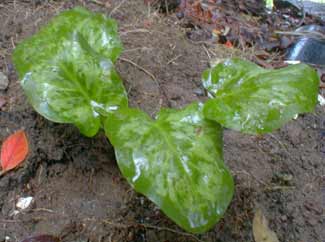
'Silver Shield'
Lords & Ladies
"Waken, lords & ladies gay,
On the mountain dawns the day."
-Sir Walter Scott
(1771-1832)
(1771-1832)
'Silver Shield' is a recent intraspecies hybrid of Arum italicum ssp marmoratum. The best-known marmoratum is usually marketed as 'Pictum,' which has more strongly arrow-shaped leaves & sharp mottled markings & silver webbing. 'Silver Shield' by contrast has cloudier mottlings, & a fatter leaf. Our young specimen erupts in late October & becomes a clump of shiny leaves for the whole of winter into spring.
Lords-&-Ladies likes a little more sun than do many shade plants, so should be placed near the edge of a shady area, where it gets more of the dappled light. If grown in deeper shade it'll have fewer leaves & grow more slowly, but will generally bloom just as reliably. We placed 'Silver Shield' in a well-draining shady ledge where its extensive root-system will keep the ledge from eroding.
Lords-&-Ladies can be a good companion plants with hellebores which likewise enjoy a bit of sun rather than complete shade & which also keep their leaves through winter. We have the arums planted with trilliums, with dogtooth lilies, & also with jack-in-the-pulpits which the Lords & Ladies' flower-spathes resemble.
When most of these plants in this garden have died to the ground in winter, it's up to Lords & Ladies to "carry" the location until spring, & two of our three varieties pull off that job very well. Both "Silver Shield" & a much bigger-leafed variety called 'Albispathum' are nice & leafy by autumn's end & get leafier throughout winter, but 'Pictum' seems always to have just a couple of leaves in early winter & only gets very leafy toward winter's end or early spring, though it is not likely that all strains & certainly not all garden conditions would result in this exact distinction.
'Albispathum' is a giant arum compared to the other two, & 'Silver Shield' is shorter even than 'Pictum.' 'Silver Shield' rarely reaches up higher than about eight inches, but can spread in time into a broad short winter clump. The flower spathe is as large as the others in May. When the spadix inside the spathe is pollinated, the leaves die back, the spathe fades & peals away, leaving a green corncob of seeds standing like a little sentinal, turning redder & redder through summer & often still standing there in autumn. Eventually the stalk softens & the seed-cob tips over on the ground where beetles & ants will carry off separateed seeds, cleaning them of pulp, then leaving the seeds to germinate elsewhere.
Occasionally arums love their location so much they begin to spread aggressively by rhyzomes & can threaten to displace nearby sensitive shade plants. Arums will pop up more distantly from insects carting off the seeds. It has naturalized in some areas of the United States & Australia where it is now an invasive pest, & occasionally gardeners regret ever having planted it, as it can be nearly impossible to exterminate should a gardener belatedly decide to remove a rampant strain.
It has never been so aggressive in our gardens (knock on woody shrubs). All three of our varieties have been well-behaved so far, & only 'Albispathum' has been particularly rapid in its growth, both 'Pictum' & 'Silver Shield' being more restrained. If some variety does seem likely to get out of hand, the colorful cob-like seed-heads can be removed before they are fully ripened in autumn, so that insects will not be taking the seeds to locations where arums might not be welcome.
There's a limit to how cold a winter arums enjoy, & in Zone 5 they would probably suffer some winter damage unless placed in a very protected area; & when grown further north, the leaves we on Puget Sound see emerging in autumn & lasting all winter into much of spring won't emerge at all until early spring. Arum is native of the Mediterranean & central Europe & Eastern Russia, as well as temperate parts of Asia & north Africa, but it likes best temperate areas such as right here in Zone 8.
Though it has a tender appearance, it is extremely hardy & forgiving of many soil conditions, acidic to mildly alkaline, hot or cold, dry or wet, sun or shade. Although ideally it would be provided with partial shade & moist acidic soil, it can also be allowed to develop more slowly in dryer shade areas where there would otherwise be no winter activity at all.